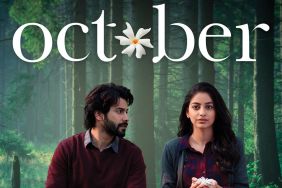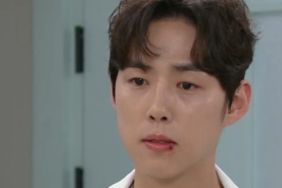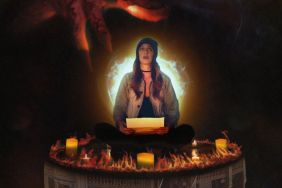The Spanish thriller coming December 5th

Sundance 2008.
Nacho Vigalondo meets us poolside at one of the many hotels housing the sundry filmmakers, producers, writers, critics and attendees here in Park City, Utah. Tonight, the Spanish filmmaker will party hard, succumb to libations and show off his karaoke skills (and I mean skills); this morning, however, he’s enjoying the warm reception following screenings of his feature debut Timecrimes. In a whirlwind, the genre amalgamation – labeled as a thriller, a sci-fi allegory, a horror film – was acquired by Magnolia’s Magnet Releasing and set up for Americanization through United Artists with Children of Men‘s Timothy J. Sexton writing and Steven Zaillian producing a remake.
Timecrimes is the cyclical story of Hector (Karra Elejalde), a husband attempting to piece his life together detail by detail after traveling back in time in less than hour. Yes, less than sixty minutes. Yet somehow, in some way, he manages to muck things up good by roping in a young woman, a scientist and a scissors-wielding killer whose face is wrapped in gauze. Vigalondo weaves a warped narrative tapestry that’s involving, unnerving and humorous. And to learn more we sat down, in the thick of the Sundance madness, to chat with the writer-director.
ShockTillYouDrop.com: Time travel is a tough thing to play with, you had to have tinkered with this for some time.
Nacho Vigalondo: This was something I didn’t think I could ever shoot because I was doing short films in Spain. But then one of my short films was nominated for an Oscar. Suddenly, this opportunity to do a feature became a reality. I wondered, what do I do now? I came back to this story, an impossible movie. So I thought, let’s try this out and see what happens. My first interest, my first crack at the script tried to make it a time travel movie in one location – that’s what I wanted to do. The most bizarre story. Just for myself. Because I love science fiction, I love paradox, I love science true stories. But I wound up going with more locations, but very few characters.
Shock: Was mapping out the events that befall your protagonist, Hector, problematical?
Vigalondo: Yeah, changing one thing in the script affected everything else. Because all of the elements are duplicated according to the story. It was incredibly complicated, and one of the challenges the main character has to face is solving an impossible puzzle. But at the same time, it’s ambitious on a very cheap level. You know, one of my favorite genres is action movies. Those are the heart of filmmaking because you can’t tell an action story in any other format, I’d love to make an action film in one location. A 90-minute climax with nothing but action in one location.
Shock: You’ll get to do a one location film one of these days… You talk about solving an impossible puzzle, did your actors catch on to this or did it take them some time to ease into what’s happening in this story?
Vigalondo: We took two days to go through it. You can imagine how complicated it was to read the script. I wrote a screenplay that was close to the film, but when the people from the finance company, then went nuts over it. They didn’t understand anything. We tried to understand the story in the deepest way possible, not just the events but the meanings.

Shock: I love the various layers you give Hector. He’s a victim, a puppet master…
Vigalondo: In the first draft of the script, it was only him. He was the only character and I wanted to do this magic trick about solving the script. It was maybe too clever or smart without heart. Three or four drafts later, I realized it had enough sense to be made. The girl came into the story and I found what the story was about. What was the heart? One guy and two girls and this love triangle, he has to choose one. He’s not a hero in a sense. He doesn’t solve the story because in movies, the heroes sacrifice. Look at I Am Legend, the last version based on the incredible story by Richard Matheson, the hero sacrifices himself. In most stories, the hero is a hero not because he wins, but because he sacrifices and I wanted to do something darker. The hero doesn’t sacrifice himself, he sacrifices another thing. He’s a victim, the killer…you don’t know.
Shock: It does end on a dark, ambiguous note, but there’s a touch of humor to it…
Vigalondo: Well, all of my short films are comedies. I never wrote a joke, or something you can laugh at while writing the script. The movie has no specific jokes, but I love to bring comedy in through the language of filmmaking. Not to give explicit permission to the audience to laugh. But I love to let people to laugh if they want to. If the situation, even the dark ones…if there’s a way to shoot it so a laugh can be had, it’s honest. You don’t always have to be serious. It’s a tragedy, but somehow if you want to laugh you should.
Shock: The man wrapped in bandages is striking and recalls two certain Universal monster classics – any particular love for those films?
Vigalondo: That came about by way of the story, really. When I discovered that element, I thought I had a monster. My first movie has a monster, this is a great! When you have a movie that has a potential icon, you’re very fortunate because it’s going to be easier for people to identify the movie with something. When you think of A Nightmare on Elm Street you don’t think of Johnny Depp, you think of Freddy Krueger, because he’s an icon. For me this is a gift to have this monster with an iconic look. A friend said to me, there’s always a moment when the monster in a horror movie reveals his face or unfolds his look and you discover who’s behind the mask. In this film…
Shock: It’s the reverse.
Vigalondo: Exactly. It’s another joke.

Shock: When we had spoken earlier, you mentioned you were under budget limitations, but it doesn’t look low budget to me. And the time travel device is particularly impressive to me. Can you talk about its design? It’s something that’s very embryonic…
Vigalondo: When we were working with the art department, I wanted people to see a contemporary design. I didn’t want something that looked like it was from the future. A big toy, something embryonic as you said, something from classic ’70s science fiction maybe. Something from childhood. Because the scientist is a confused child almost. He doesn’t understand it all. It’s shocking to him. I did want a ton of lights and stuff. I wanted it to feel like it was something you could believe.
Shock: To you, what’s the significance of the Blondie song “Picture This”? An old personal favorite of yours?
Vigalondo: When you put in a song, you feel a bit guilty ’cause you like it. It’s risky. But the time machine issue makes you put it in over and over again. Every time the song comes on, it carries a different feeling. I had this risk of using the wrong song. But what I like about “Picture This,” I love the arrangement of the song and the chords. It’s a happy song, but it’s very sad and it’s close to the movie. This is a B-movie sci-fi genre horror film, but at the same time it’s very sad. It has a huge sadness at the end.
Timecrimes opens in limited release on December 5th. For Vigalondo’s comment on the upcoming remake visit our story here.



Source: Ryan Rotten









